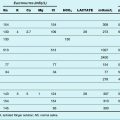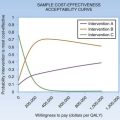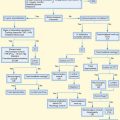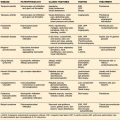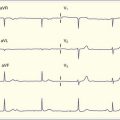205 Platelet Disorders
• Immune thrombocytopenic purpura (ITP) is a diagnosis of exclusion.
• Immunomodulation, in patients with suspected ITP, should be done in consultation with a hematologist.
• Thrombocytopenia with microangiopathic hemolytic anemia is sufficient to make the diagnosis of thrombotic thrombocytopenic purpura (TTP) and to initiate plasma exchange.
• TTP should be considered in patients with severe preeclampsia or HELLP (hemolysis, elevated liver enzymes, low platelets) syndrome.
• TTP and hemolytic uremic syndrome (HUS) are distinguished by the primary organ dysfunction: brain in TTP and kidney in HUS.
• TTP-HUS is distinguished from disseminated intravascular coagulation by the lack of coagulation abnormalities.
• Drug-induced thrombocytopenia should be considered in patients with acute or chronic exposure to implicated medications.
• Heparin-induced thrombocytopenia leads to thromboses in both arterial and venous beds.
• Patients with primary or essential thrombocythemia are at risk for both thrombotic and bleeding complications.
• Patients with essential thrombocythemia and thrombotic complications should be treated with cytoreductive treatments and considered for platelet pheresis.
• Pulses are maintained in patients with essential thrombocythemia who have thromboses.
Perspective
Patients presenting with primary platelet disorders are rare in the emergency department (ED). Although emergency physicians commonly encounter patients with thrombocytosis, thrombocytopenia, and dysfunctional platelets, these disorders are usually observed in the context of another illness. When abnormalities of the platelet count are discovered, the challenge is to identify the primary process and determine whether the patient has an associated life-threatening condition (Box 205.1).
Idiopathic or Immune Thrombocytopenic Purpura
Epidemiology
Immune thrombocytopenic purpura (ITP) is an autoimmune disorder characterized by isolated thrombocytopenia. The estimated incidence is 100 cases per 1,000,000 patients, and half of the cases are seen in children. In children, the gender distribution is equal, whereas in adults, women are three times more likely to be affected than are men.1 ITP is defined as chronic if it lasts for longer than 6 months. Eighty percent of children with ITP have the acute form, whereas 80% of adults with ITP develop the chronic illness.2
Pathophysiology
Thrombocytopenia in ITP is primarily the result of accelerated platelet destruction. Autoantibodies bind to platelet antigens and thus lead to accelerated clearance by macrophages found primarily in the spleen and the liver. This increased clearance is magnified by decreased production caused by intramedullary destruction of platelets and megakaryocyte inhibition.3 Thrombocytopenia, in turn, leads to bleeding through loss of the integrity of the vascular wall and deficits in thrombus formation.
Presenting Signs and Symptoms
Patient’s symptoms of bleeding depend on the severity of the thrombocytopenia. Patients with platelet counts higher than 50,000/mm3 are asymptomatic. Patients with platelet counts lower than 50,000/mm3 may report easy bruising with minor trauma, whereas patients with platelet counts between 10,000 and 30,000/mm3 can have spontaneous petechiae and bruising. Patients with platelet counts lower than 10,000/mm3 are at risk for internal bleeding, including intracranial hemorrhage (ICH).4
ICH is the major cause of mortality in patients with ITP.1 The mortality rate of patients with ITP and ICH is greater than 50%.5 Atraumatic ICH secondary to ITP is rare, estimated to occur in 0.1% to 1% of patients with ITP. In one report of patients with ICH, 70% had platelet counts lower than 10,000/mm3.5 Despite the rarity of this complication, patients with ITP and any cranial or neurologic complaint should be evaluated for ICH.
Treatment
Steroids are usually started at a dose 1 to 1.5 mg/kg of prednisone per day. IVIG (usual dose of 1 g/kg) is reserved for infants and patients with severe disease or internal bleeding. Anti-D immune globulin is used as an adjunct in Rh-positive patients (usual dose of 75 mcg/kg). Patients with a recurrence of ITP are treated in the same manner as patients with an initial presentation of ITP and should be considered for escalation of therapy. Patients who have chronic or refractory ITP should be considered for splenectomy. The rate of remission of ITP after splenectomy in children is 70% to 80%. The remission rate in adults is unpredictable, ranging from 60% to 70%.1 Platelet transfusion leads to a rapid but transient increase in platelet count and is therefore indicated only in certain settings, such as in patients with bleeding complications, patients undergoing emergency surgery, and those with severe thrombocytopenia.
Thrombotic Microangiopathies
Epidemiology
TTP and HUS are rare diseases. TTP has an estimated prevalence of 4 to 11 cases per million people,6 and HUS has an incidence of 1 to 10 cases per 100,000.7 TTP is associated with black race, female sex, and obesity.8 Pregnant and peripartum patients account for 12% to 25% of patients with TTP.9
Despite the rarity, TTP and HUS are associated with significant morbidity and mortality. Untreated TTP has a mortality rate of 90%,10 and adults with typical HUS have a 45% mortality rate.11 Children less than 10 years of age have a 15% chance of developing HUS in the setting of diagnosed Escherichia coli O157:H7 infection.12 Although 90% of children with typical Shiga toxin–associated HUS recover with supportive care,13,14 they have a 12% rate of death or permanent end-stage renal disease and a 25% incidence of hypertension and proteinuria.13 Shiga toxin–associated HUS is the most common cause of acute renal failure in childhood, and it accounts for 4.5% of pediatric patients who undergo long-term renal replacement therapy.7 Commonly cited risk factors for developing HUS include antibiotic administration, use of antimotility agents, and age younger than 10 years.15
Pathophysiology
In classic HUS, the inciting event is typically an infection with Shiga toxin–releasing bacteria, most commonly E. coli O157:H7 and non-O157:H7 subtypes.12 The toxin produced by the bacteria is systemically absorbed, thus leading to widespread microvascular injury and consequent thrombosis. For unknown reasons, most cases of thrombosis in HUS occur in the renal vasculature. Ten percent of cases of HUS are atypical and are not triggered by Shiga toxin.16 The triggers in atypical HUS include pregnancy, autoimmune disorders, drug toxicity, malignant disease, drug reactions, and preceding infections.17
Most patients with TTP have an acquired deficit in the protease ADAMTS-13 that is typically caused by autoantibody destruction. This deficit in ADAMTS-13 leads to the inability to cleave von Willebrand factor multimers and causes intravascular platelet aggregation and thrombosis.14 Genetic susceptibility to the development of TTP has been described but is not well characterized.16 Although most patients with TTP are characterized as having idiopathic TTP, ADAMTS-13 antibodies have also been associated with medications (e.g., quinine, ticlopidine, clopidogrel8,18), pregnancy, autoimmune disorders, direct drug toxicity, and hematopoietic stem cell transplantation.8 TTP is treated with plasma exchange, which is thought to work by both removing the autoantibodies against ADAMTS-13 and replacing ADAMTS-13 activity.
Presenting Signs and Symptoms
Despite the classic descriptions of both TTP and HUS, the most common symptoms are nonspecific. Patient typically present with complaints of abdominal pain, nausea, vomiting, and weakness and are frequently misdiagnosed as having gastroenteritis, sepsis, or transient ischemic attack.8 Even when the diagnosis is made, 10% of patients with an initial diagnosis of TTP in one report were eventually found to have sepsis or systemic cancer.19
Differential Diagnosis and Medical Decision Making
Several elements of the patient’s history should alert the clinician to the possibility of TTP-HUS. HUS should be considered in children with symptoms of renal failure after a diarrheal illness. TTP should be considered in patients presenting after initiating antiplatelet agents, especially in the first 3 to 14 days. Although TTP is considered an acute illness, one fourth of patients report symptoms for several weeks before diagnosis.8
Pregnant and peripartum patients with suspected TTP are a diagnostic and clinical challenge. Pregnant patients account for a large percentage of cases of TTP,9 and clinical overlap exists between TTP and preeclampsia-HELLP (hemolysis, elevated liver enzymes, low platelets) syndrome. Clinically, the two diseases have vastly divergent treatment. Patients with TTP and preeclampsia-HELLP have thrombocytopenia, microangiopathic anemia, renal disease, and neurologic abnormalities. Both diseases are seen primarily in the second and third trimesters. Distinguishing features include more severe hypertension in preeclampsia. The renal dysfunction in patients with preeclampsia is typically proteinuria, compared with the frank renal failure and oliguria seen in TTP-HUS. The thrombocytopenia in preeclampsia tends to be milder and corrects rapidly after delivery. The neurologic abnormalities in preeclampsia are typically headache, scotoma, and seizure, unlike the cerebrovascular accident or mental status change seen in TTP. Pregnant patients with possible TTP should have care coordinated among obstetrics, hematology, and nephrology.
Treatment
The treatment for TTP is plasma exchange.10 Plasma exchange halts the thrombosis by removing the autoantibodies against ADAMTS-13 and replacing the ADAMTS-13. Plasma exchange should start within 24 hours of presentation. If plasma exchange is not available or will be severely delayed, plasma infusion at 30 mL/kg/day may be attempted. Immunosuppression with glucocorticoids is used as an adjunct in patients with idiopathic ITP and in patients who have exacerbations after plasma exchange is stopped or in patients who have a relapse after remission.20 The dose of prednisone is 1 to 2 mg/kg/day. Some weak evidence indicates that additional immunosuppression with cyclophosphamide or vincristine may be beneficial, but it is not routinely recommended.8 When clopidogrel or ticlodipine is the suspected cause, the medication must be discontinued.
The treatment of HUS varies among patient populations. The treatment of children with typical Shiga toxin–associated HUS centers around aggressive supportive care, including fluid and electrolyte management, blood pressure management, red blood cell transfusion, and dialysis when indicated. Plasma exchange or plasma infusion is not routinely indicated for the treatment of typical HUS. Plasma exchange should be considered in patients with HUS that is not associated with Shiga toxin–associated diarrhea,16 in adults, in patients with neurologic abnormalities, and in those who are very ill.7
Follow-Up, Next Steps of Care, and Patient Education
Patients should be educated about the possibility of long-term sequelae, including renal failure, permanent neurologic disability, and myocardial dysfunction, as well as the possibility of relapse. The long-term prognosis depends on various factors, including age, degree of organ dysfunction, prompt treatment with plasma exchange, and length of time undergoing dialysis. Children universally do better than adults. Young children with typical (Shiga toxin diarrhea–associated) HUS have the best prognosis of all patients with TTP-HUS. Patients with typical HUS are unlikely to have a recurrence, whereas patients with idiopathic TTP have a 50% relapse rate.8
Drug-Induced Thrombocytopenia
Epidemiology
The diagnosis of drug-induced thrombocytopenia is challenging. More than 150 drugs have been implicated (Box 205.2),21 but the epidemiology is not well characterized because of the dual lack of consistent, high-quality reporting and diagnostic criteria. This rare disease has an estimated incidence of 10 cases per 1,000,000 patients, but it occurs more frequently in hospitalized patients and in older persons.22 Reported incidences of thrombocytopenia induced by specific medications have ranged from 0.0003% with quinine to 1% with gold salts and abciximab. This diagnosis is important to consider because the only effective treatment is discontinuation of the medication. Drug-induced thrombocytopenia does not respond to immunomodulation, as do conditions such as ITP.
Box 205.2
Drugs Commonly Implicated in Drug-Induced Thrombocytopenia
Date from George J, Raskob G, Shah S, et al. Drug-induced thrombocytopenia: a systematic review of published case reports. Ann Intern Med 1998;129:886–90.
Heparin-induced thrombocytopenia (HIT) must be considered separately from all other forms of drug-induced thrombocytopenia. HIT is more common than other drug-induced thrombocytopenias, with an incidence as high as 5% in high-risk populations.23 Additionally, it has a much higher rate of both morbidity and mortality from thrombotic complications, which can persist after the heparin is discontinued and platelet levels return to normal. The risk of developing thrombocytopenia is 10 times higher in patients who are exposed to unfractionated heparin, when compared with those receiving low-molecular-weight heparin.24
Pathophysiology
In drug-induced thrombocytopenia, the drop in platelets is an immunologic process. The drugs themselves are not immunogenic. When the drug is bound to the platelet, however, the drug-platelet complex induces antibody production. The key feature of most of these antibodies is that they are not true autoantibodies because they do not bind to the platelet if the drug is not bound. Very rarely, drugs can induce true autoantibodies that can bind to the platelet in the absence of the drug. This phenomenon is most commonly seen during treatment with gold salts, but it also occurs with procainamide, sulfonamides, and interferon-α and -β.22
Presenting Signs and Symptoms
In contrast to the other type of drug-induced thrombocytopenia, 20% to 50% of patients with HIT present with thrombotic complications. Of these thromboses, 70% are venous, and 30% are arterial.25 The clinical presentation of patients with thrombotic complications from HIT depends on the vascular bed that is involved. The venous thromboses are most commonly deep vein thromboses and pulmonary emboli, but they also include cerebral and adrenal venous thromboses. The arterial thromboses are reported in the limbs, aorta, cerebral, and coronary vasculatures.
Treatment
Patients with severe thrombocytopenia or bleeding should be treated with platelet transfusion. Immunomodulating medications such as corticosteroids, IVIG, and plasma transfusion have been tried, without any conclusive evidence supporting their efficacy.22
Thrombocytosis
Epidemiology
Thrombocytosis is usually an incidental finding in a patient in the ED. Most patient have secondary thrombocytosis, from an acute or chronic condition such as infection or malignant disease. Even in the extremes of thrombocytosis with platelet counts greater than 1,000,000/mm3, 88% of patients have reactive thrombocytosis.26
The other main cause of thrombocytosis is essential thrombocythemia (ET), which is one of the myeloproliferative disorders. ET is a relatively rare disease with an estimated incidence of 2.5 cases per 100,000 patients.27 In contrast to reactive thrombocytosis, patients with ET are prone to both bleeding and thrombotic complications.
Pathophysiology
Platelet production and homeostasis are primarily controlled by the effects of thrombopoietin on the megakaryocytes. Thrombocytosis can either be primary or secondary. In primary thrombocytopenia (ET), the thrombocytosis results from the clonal proliferation of megakaryocytes. Secondary thrombocytosis is caused by the effects of various catechols and cytokines,28 as well as increased production of thrombopoietin in the liver in response to inflammatory stimuli.29
Presenting Signs and Symptoms
Patients with ET can present with both bleeding and thrombotic complications. Thrombotic complications are more common that bleeding complications, with a ratio of 11 : 1, and arterial thrombosis is more common than venous thrombosis, with a ratio of 3 : 1.30
The bleeding complications are similar to those seen with thrombocytopenia and qualitative platelet disorders. Findings may include petechiae, hematuria, and gastrointestinal bleeding. Counterintuitively, these bleeding complications are more likely to occur in the extremes of thrombocytosis.28
The thrombotic complications of ET are common. Fifty percent of patients with ET have at least one thrombotic complication in the first 9 years from diagnosis.30 The thrombotic complications have an unusual distribution. In addition to deep vein thromboses, patient are at risk for developing venous thromboses of the cerebral, hepatic, and portal veins. Most arterial complications are cerebrovascular, accounting for symptoms ranging from migraine-like symptoms to transient ischemic attack and stroke.30,31 Despite its relative rarity, ET is classically associated with digital ischemia and erythromelalgia, which is characterized by patchy burning or throbbing pain in the extremities. Associated skin findings range from mottling, to erythema, to absent. Erythromelalgia can progress to gangrene and necrosis if it is not treated. In addition, patients with ET are at extreme risk for pregnancy-related complications, including fetal growth retardation and recurrent spontaneous abortions, because of placental thromboses.
Treatment
Patients with symptomatic ET must be treated aggressively. Patients with arterial thrombotic complications should have a combination of aspirin and cytoreductive therapy with hydroxyurea, anagrelide, or interferon-α. In addition, patients should be considered for platelet pheresis especially if they have cerebral and digital ischemia.28 ED initiation of treatment for asymptomatic patients with suspected ET is not indicated. Patients should be referred to hematology and to their primary care physician for further evaluation.
Cines D, Blanchette V. Immune thrombocytopenic purpura. N Engl J Med. 2002;346:995–1008.
George JN. Clinical practice: thrombotic thrombocytopenic purpura. N Engl J Med. 2006;354:1927–1935.
McMinn J, George J. Evaluation of women with clinically suspected thrombotic thrombocytopenic purpura-hemolytic uremic syndrome during pregnancy. J Clin Apher. 2001;16:202–209.
Moake JL. Thrombotic microangiopathies. N Engl J Med. 2002;347:589–600.
Schafer AI. Thrombocytosis. N Engl J Med. 2004;350:1211–1219.
1 Cines D, Blanchette V. Immune thrombocytopenic purpura. N Engl J Med. 2002;346:995–1008.
2 Kühne T, Buchanan G, Zimmerman S. A prospective comparative study of 2540 infants and children with newly diagnosed idiopathic thrombocytopenic purpura (ITP) from the Intercontinental Childhood ITP. J Pediatr. 2003;143:605–608.
3 Gernsheimer T, Stratton J, Ballem P, Slichter S. Mechanisms of response to treatment in autoimmune thrombocytopenic purpura. N Engl J Med. 1989;320:974–980.
4 McMillan R. Therapy for adults with refractory chronic immune thrombocytopenic purpura. Ann Intern Med. 1997;126:307–314.
5 Butros L, Bussel J. Intracranial hemorrhage in immune thrombocytopenic purpura: a retrospective analysis. J Pediatr Hematol Oncol. 2003;25:660.
6 Terrell DR, Williams LA, Vesely SK, et al. The incidence of thrombotic thrombocytopenic purpura-hemolytic uremic syndrome: all patients, idiopathic patients, and patients with severe ADAMTS-13 deficiency. J Thromb Haemost. 2005;3:1432–1436.
7 Scheiring J, Andreoli SP, Zimmerhackl LB. Treatment and outcome of Shiga-toxin–associated hemolytic uremic syndrome (HUS). Pediatr Nephrol. 2008;23:1749–1760.
8 George JN. Clinical practice: thrombotic thrombocytopenic purpura. N Engl J Med. 2006;354:1927–1935.
9 McMinn J, George J. Evaluation of women with clinically suspected thrombotic thrombocytopenic purpura-hemolytic uremic syndrome during pregnancy. J Clin Apher. 2001;16:202–209.
10 Rock G, Shumak K, Buskard N, et al. Comparison of plasma exchange with plasma infusion in the treatment of thrombotic thrombocytopenic purpura. N Engl J Med. 1991;325:393–397.
11 Dundas S, Murphy J, Soutar RL, et al. Effectiveness of therapeutic plasma exchange in the 1996 Lanarkshire Escherichia coli O157:H7 outbreak. Lancet. 1999;354:1327–1330.
12 Tarr P. Shiga toxin-associated hemolytic uremic syndrome and thrombotic thrombocytopenic purpura: distinct mechanisms of pathogenesis. Kidney Int Suppl. 2009;112:S29–S32.
13 Garg A, Suri R, Barrowman N, et al. Long-term renal prognosis of diarrhea-associated hemolytic uremic syndrome: a systematic review, meta-analysis, and meta-regression. JAMA. 2003;290:1360.
14 Moake JL. Thrombotic microangiopathies. N Engl J. Med 2002;347:589–600.
15 Tarr P, Gordon C, Chandler W. Shiga-toxin-producing Escherichia coli and haemolytic uraemic syndrome. Lancet. 2005;365:1073–1086.
16 Noris M, Remuzzi G. Atypical hemolytic-uremic syndrome. N Engl J Med. 2009;361:1676.
17 Veyradier A, Meyer D. Thrombotic thrombocytopenic purpura and its diagnosis. J Thromb Haemost. 2005;3:2420–2427.
18 Bennett C, Connors J, Carwile J. Thrombotic thrombocytopenic purpura associated with clopidogrel. N Engl J Med. 2000;342:1773–1777.
19 George J, Vesely S, Terrell D. The Oklahoma thrombotic thrombocytopenic purpura-hemolytic uremic syndrome (TTP-HUS) registry: a community perspective of patients with clinically diagnosed TTP-HUS. Semin Hematol. 2004;41:60–67.
20 Allford S, Hunt B, Rose P, Machin S. Guidelines on the diagnosis and management of the thrombotic microangiopathic haemolytic anaemias. Br J Haematol. 2003;120:556–573.
21 George J, Raskob G, Shah S, et al. Drug-induced thrombocytopenia: a systematic review of published case reports. Ann Intern Med. 1998;129:886–890.
22 Aster R, Bougie D. Drug-induced immune thrombocytopenia. N Engl J Med. 2007;357:580.
23 Warkentin T, Sheppard J, Horsewood P. Impact of the patient population on the risk for heparin-induced thrombocytopenia. Blood. 2000;96:1703–1708.
24 Martel N, Lee J, Wells P. Risk for heparin-induced thrombocytopenia with unfractionated and low-molecular-weight heparin thromboprophylaxis: a meta-analysis. Blood. 2005;106:2710–2715.
25 Greinacher A, Farner B, Kroll H. Clinical features of heparin-induced thrombocytopenia including risk factors for thrombosis: a retrospective analysis of 408 patients. Thromb Haemost. 2005;94:132–135.
26 Buss D, Stuart J, Lipscomb G. The incidence of thrombotic and hemorrhagic disorders in association with extreme thrombocytosis: an analysis of 129 cases. Am J Hematol. 1985;20:365–372.
27 Mesa R, Silverstein M, Jacobsen S. Population-based incidence and survival figures in essential thrombocythemia and agnogenic myeloid metaplasia: an Olmsted county study, 1976-1995. Am J Hematol. 1999;61:10–15.
28 Schafer AI. Thrombocytosis. N Engl J. Med 2004;350:1211–1219.
29 Wolber E, Fandrey J, Frackowski U, Jelkmann W. Hepatic thrombopoietin mRNA is increased in acute inflammation. Thromb Haemost. 2001;86:1421–1424.
30 Bazzan M, Tamponi G, Schinco P, et al. Thrombosis-free survival and life expectancy in 187 consecutive patients with essential thrombocythemia. Ann Hematol. 1999;78:539–543.
31 Schafer A. Thrombocytosis and thrombocythemia. Blood Rev. 2001;15:159–166.

